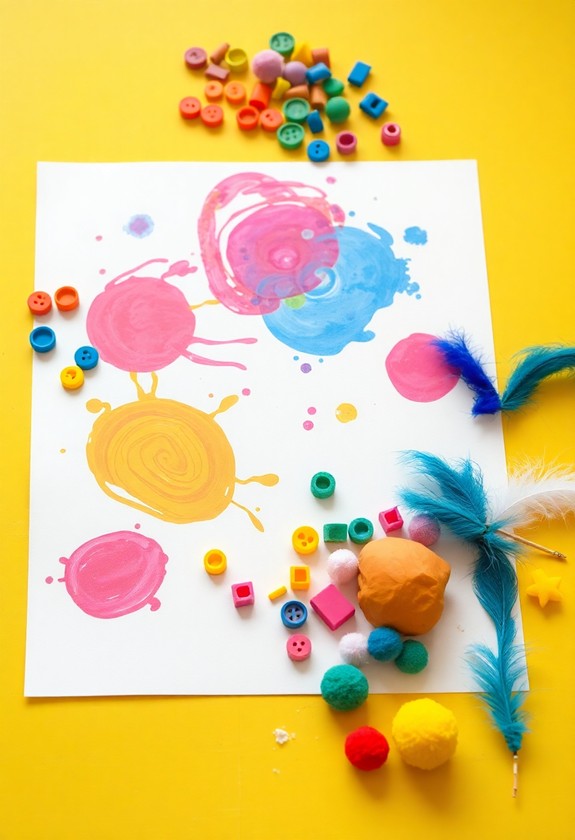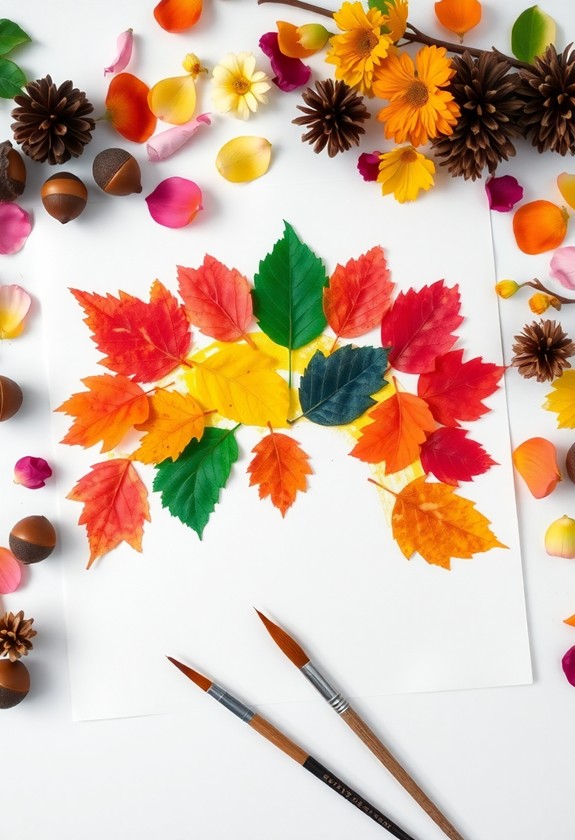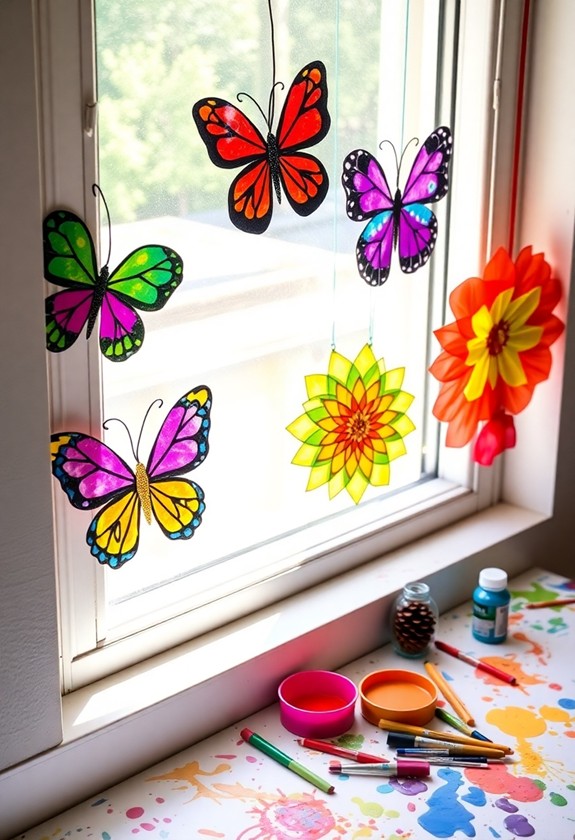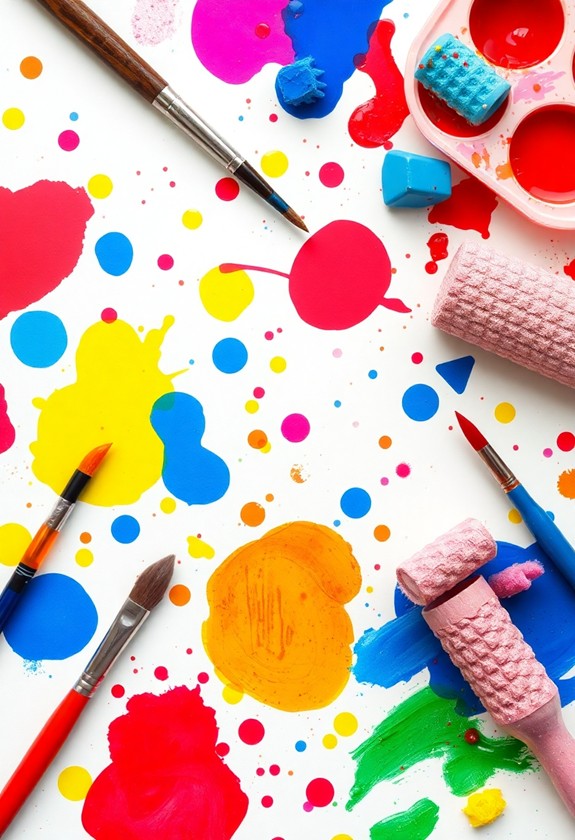Get ready for sensory art fun that'll boost your toddler's fine motor skills! Try finger painting with pudding, creating spaghetti noodle masterpieces, or sculpting with PlayDoh. Immerse yourself in a rainbow rice sensory bin, make shaving cream canvas art, or go on a sandbox treasure hunt. Let them investigate water beads, make bubble wrap stamp paintings, or squish sensory bags. These activities engage multiple senses, spark creativity, and develop essential motor skills. Your little one will love squishing, molding, and investigating different textures as they learn through play. But wait, there's more to uncover about each exciting activity!
Creative Highlights
- Finger painting with pudding engages multiple senses while developing fine motor skills through squishing and creating designs.
- Textured collage making promotes fine motor skills through gluing and arranging various materials like fabric and feathers.
- PlayDoh sculpture gardens encourage imagination and develop fine motor skills through molding and shaping.
- Rainbow rice sensory bins stimulate visual senses and promote fine motor skills through scooping, pouring, and sorting activities.
- Spaghetti noodle art improves fine motor skills and hand-eye coordination while allowing for creative textural manipulation.
Finger Painting With Pudding

Three key ingredients make pudding finger painting a perfect sensory activity for toddlers: it's safe, messy, and delicious. Get ready for some squishy, squelchy fun!
Here's what you'll need:
- Instant pudding mix
- Milk
- Large tray or table cover
- Smock or old clothes
Mix up the pudding according to package directions. Spread it out on a tray or covered table. Now, let your little one plunge into it! They'll love squishing the cool, creamy pudding between their fingers and creating swirly designs. This eco-friendly art option promotes sustainability during the process of easy cleanup, making it ideal for busy parents who want to encourage creativity without the traditional mess.
Encourage exploration by asking:
- How does it feel?
- Can you make shapes?
- What happens when you mix colors?
This activity is a feast for the senses! It's visually stimulating, tactilely engaging, and even tasty. Plus, it's great for developing fine motor skills. Get ready for giggles and pudding-covered smiles!
Spaghetti Noodle Art

From edible finger paints, let's move on to another kitchen-inspired art activity. Spaghetti noodle art is a fantastic way to engage your toddler's senses and improve their creativity! Cook up some spaghetti noodles, let them cool, and you're ready to go. Here's how to set it up:
- Divide the noodles into small bowls
- Add food coloring to each bowl
- Mix well to create colorful "noodle paint"
Now, let your little artist loose! They can squish, squash, and stretch the noodles on paper or a tray. This sensory investigation activity not only improves creativity but also promotes tactile learning and fine motor skill development. Watch as they create wiggly masterpieces! This activity is perfect for developing fine motor skills and hand-eye coordination. Plus, it's just plain fun! Don't be surprised if you hear giggles and "oohs" as they investigate different textures. Who knew pasta could be so artistic?
PlayDoh Sculpture Garden

Imagination blooms in a PlayDoh sculpture garden! This lively activity will have your toddler's creativity soaring as they mold and shape colorful dough into a fanciful wonderland. You'll love watching their little fingers work, developing essential fine motor skills as they have a blast! This open-ended craft encourages storytelling and imagination, making it perfect for toddlers with short attention spans. Plus, the eco-friendly and non-toxic nature of PlayDoh aligns with parents' safety concerns.
Here's why PlayDoh sculpture gardens are fantastic:
- Endless possibilities for creative expression
- Soft texture is perfect for little hands
- Easy clean-up makes it a parent-favorite
To get started, gather an assortment of PlayDoh colors and small plastic flowers or figurines. Show your child how to roll, squeeze, and pinch the dough into various shapes. Encourage them to create flowers, trees, and even tiny critters! As their garden grows, they'll be cultivating imagination and dexterity. Don't forget to display their masterpiece and watch their confidence bloom!
Rainbow Rice Sensory Bin

Plunge into a world of lively colors and textures with a rainbow rice sensory bin! This colorful activity will dazzle your toddler's senses and boost their fine motor skills. Here's how to create this magical sensory experience:
- Divide uncooked rice into separate bowls
- Add food coloring to each bowl (one color per bowl)
- Mix until rice is evenly colored
- Let the rice dry completely
This non-toxic, washable option guarantees mess-free creativity as it promotes cognitive development and emotional well-being. Now, pour your rainbow rice into a large bin and watch your little one's eyes light up! Add scoops, cups, and funnels for extra fun. They'll love running their fingers through the colorful grains, sifting, pouring, and creating miniature environments. It's a rice-ly good time! But wait, there's more! Hide small toys in the bin for a thrilling treasure hunt. Your toddler will be having so much fun, they won't even realize they're developing essential skills!
Shaving Cream Canvas Creations

Get ready for a messy masterpiece with shaving cream canvas creations! This activity is perfect for little hands and big imaginations. You'll need:
- Shaving cream
- Food coloring or washable paint
- A flat surface or tray
Squirt a generous amount of shaving cream onto your surface. It's time to get creative! Let your toddler mix in drops of food coloring or paint, swirling and spreading the colors with their fingers. Watch as they create swirls, patterns, and unique designs in the fluffy canvas. This multi-sensory experience aids in memory retention and information processing, essential for early childhood development. Regular engagement in such activities stimulates brain regions associated with problem-solving, creativity, and motor skills.
But wait, there's more! Try using tools like combs, forks, or even toy cars to make tracks and textures. When your little artist is finished, press a sheet of paper onto the creation to make a one-of-a-kind print. It's double the fun and double the art!
Textured Collage Making

Countless textures await your toddler's curious fingers in this engaging collage-making activity. Get ready for a tactile adventure! Gather materials like:
- Fabric scraps
- Feathers
- Sandpaper
- Bubble wrap
- Yarn
- Foam shapes
Now, let's get sticking! Spread glue on a sturdy piece of cardboard and let your little one go wild. They'll love feeling the different textures as they create their masterpiece. Encourage them to squish, pat, and press the materials onto the surface. It's a sensory bonanza!
This activity isn't just fun – it's fantastic for developing fine motor skills and sensory awareness. Plus, it's a great way to introduce new vocabulary. "Ooh, that's smooth!" or "Wow, so fuzzy!" Your toddler will be texture-tastic in no time!
Sandbox Treasure Hunt

Digging for treasure in a sandbox is a thrilling sensory experience for toddlers. It's a fantastic way to engage their senses and develop fine motor skills! You'll need a sandbox, small toys, and some shovels or scoops. Hide the toys in the sand and let your little one's adventure begin!
- Buried treasures await exploration!
- Tiny hands get a sandy workout
- Excitement builds with each find
Watch as your toddler's eyes light up with each new revelation! They'll love the feel of sand between their fingers and the satisfaction of unearthing hidden gems. This activity isn't just fun – it's educational too! Your child will learn about textures, practice hand-eye coordination, and develop problem-solving skills. So grab your shovels and get ready for a sensory-filled treasure hunt that'll have your toddler giggling with joy!
Water Bead Sorting

Water bead sorting offers a mesmerizing sensory experience for toddlers. It's a fantastic way to engage their senses and boost fine motor skills! Here's how to set it up:
- Soak colorful water beads overnight
- Place them in a large, shallow container
- Provide small cups or bowls for sorting
Let your little one plunge in and investigate the squishy, slippery beads! They'll love the cool, wet texture and lively colors. Encourage them to sort the beads by color or size – it's a great way to introduce basic concepts during fun!
But wait, there's more! Try these exciting variations:
- Add small toys for a "treasure hunt"
- Use tweezers for an extra fine motor challenge
- Freeze beads for a chilly twist
Bubble Wrap Stamp Painting

From squishy beads to bubbly textures, let's examine another exciting sensory activity for toddlers. Bubble wrap stamp painting is a fantastic way to engage your little one's senses and boost their creativity! This fun-filled activity combines tactile engagement with artistic expression.
Here's why your toddler will love it:
- Satisfying popping sounds
- Unique textures to investigate
- Colorful, bubbly patterns
To get started, grab some bubble wrap, paint, and paper. Cut the bubble wrap into manageable pieces for tiny hands. Pour different paint colors onto plates. Now, let your toddler dip the bubble wrap into the paint and press it onto the paper. Watch their eyes light up as they create amazing bubble-inspired masterpieces! This activity isn't just fun – it's also great for developing fine motor skills and hand-eye coordination. So, get ready for a poppin' good time!
Sensory Squish Bags

After examining bubble wrap painting, let's plunge into the squishy world of sensory squish bags. These fun-tastic creations are a blast for toddlers! You'll need:
- Ziplock bags
- Hair gel or clear glue
- Food coloring
- Small toys or glitter (optional)
Here's how to make 'em:
- Fill the bag with hair gel or glue
- Add a few drops of food coloring
- Toss in small toys or glitter (if desired)
- Seal the bag tightly, removing excess air
- Secure edges with tape for extra protection
Now, let your little one squish, squash, and investigate! They'll love the cool, slimy texture and lively colors. Plus, it's mess-free fun! Encourage them to trace shapes, letters, or numbers on the bag. It's a squishy sensation that'll have them giggling with glee!
Curious Little Questions
What Age Range Is Considered 'Toddler' for These Sensory Art Activities?
You're in for a treat! When we talk about toddlers, we're usually referring to little ones between 1 and 3 years old. It's an exciting time full of growth and revelation! These kiddos are bursting with energy and curiosity, making them perfect candidates for sensory art activities. Remember, every child develops at their own pace, so don't worry if your little one's a bit ahead or behind. The key is to have fun and investigate together! Let's get messy and creative!
How Can I Modify These Activities for Children With Sensory Sensitivities?
You can make sensory activities more accessible for sensitive kiddos! Here are some tips:
- Start small: Introduce textures gradually
- Offer choices: Let them pick materials they're comfortable with
- Use tools: Provide paintbrushes or spoons for messy play
- Create barriers: Use gloves or plastic wrap for hands-off exploration
- Adjust intensity: Dilute scents or soften sounds
- Be patient: Let them set the pace
Are There Any Allergen-Free Alternatives for Food-Based Sensory Activities?
You've got plenty of allergen-free options for sensory fun! Try these exciting alternatives:
- Use colorful rice or pasta (dyed with food coloring)
- Create a bin of pom-poms or cotton balls
- Fill containers with water beads or gel beads
- Make slime with glue and borax (supervised play)
- Use kinetic sand or moon sand
These options are just as thrilling and tactile as food-based activities, but without the worry! You'll see your little one's eyes light up as they squish, squeeze, and investigate these safe, allergen-free sensory materials. Let the mess-free fun begin!
What Safety Precautions Should Be Taken During Sensory Art Activities?
Are you ready to plunge into the world of sensory art? Let's make it safe and fun! Here's what you need to know:
- Always supervise your little artist closely!
- Choose non-toxic, washable materials
- Avoid small items that could be choking hazards
- Keep sharp objects out of reach
- Use smocks or old clothes to protect skin and clothing
- Have a first-aid kit handy, just in case
- Clean up spills swiftly to prevent slips
How Can I Incorporate Learning Objectives Into These Sensory Art Experiences?
You can easily sneak learning into sensory art, making it fun and educational! Try these exciting ideas:
- Count objects as you create (1, 2, 3 pom-poms!)
- Name colors during painting ("Look at that blue sky!")
- Introduce shapes through stickers or cutouts
- Practice letters with alphabet pasta or foam pieces
- Investigate textures and describe them ("Ooh, it's squishy!")
- Use nature items to learn about seasons




